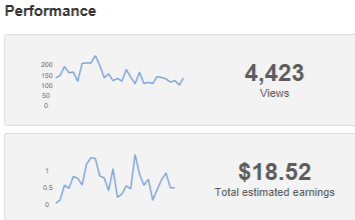We have already chosen an affiliate niche , but of course several factors played a role.
Today it's all about the question of whether and, if so, how much money I can make with the topic that I cover in my blog or website.
This is of course particularly interesting for existing websites and blogs.
Is my blog topic profitable?
Unfortunately, at the beginning I have to answer this question like this: You can't say that across the board.
Of course, you can never say exactly how profitable a topic is in advance. But the question of whether a topic can be profitable can only be answered to a limited extent.
It is not uncommon for two blogs/websites with the same topic to have varying degrees of success in affiliate marketing.
But what can be clarified in advance is the fundamental potential of a topic.
Factors for a profitable topic
Are there ways to calculate in advance whether a topic will be profitable given a certain number of visitors?
The problem is that there are several variables that affect profitability:
Existing/potential targeted traffic
One of the most important factors in determining whether a topic is profitable is the number of visitors to your blog/website.
Of course, the more “real” visitors, the greater the income potential. By “correct” I mean visitors who are interested in the advertised product or are otherwise a clear target group.
Using tricks to get visitors to your website usually doesn't help with affiliate programs.
But if you manage to get visitors with a specific interest (e.g. looking for health insurance) to your affiliate page, then that's ideal.
Existing traffic
That's why you should first look at your previous visitors. Which pages do they come from and which keywords did they enter into Google? For this you can, for example, use Google Analytics or another statistics solution.
This data already gives a good indication of what interests existing visitors have.
Potential traffic.
When it comes to potential traffic, you should make use of one or two online tools.
In the relatively new “Google Keyword Tool based on search queries” you can browse through categories and see the search queries per month for individual keywords.
The basic rule here is that a lot of traffic for the right search terms is good.
What are good visitor numbers?
The question “What are good visitor numbers?” comes up again and again. This cannot be answered in general terms either. I know websites that have as much traffic as this blog and earn many times as much. This question focuses too much on the quantitative number. It is important to have as much “real” traffic as possible.
If you have 5,000 visitors per month on a website for a very specific topic for which there are very lucrative partner programs, then that is worth more than 50,000 “across the board” visitors who have neither a specific interest in buying nor where there are good partner programs for .
Websites specifically built for affiliate marketing often require fewer visitors for a certain level of income than a normal blog, which can only be partially optimized for affiliate marketing. At least that's my experience.
What affiliate programs are there?
Even though I'm dedicating a separate article to finding the right partner programs, I have to mention this point here.
From an affiliate perspective, a topic can only be profitable if there are worthwhile partner programs for it.
The number of partner programs is an interesting factor, but more partner programs do not always mean higher profits.
At Tradedoubler, for example, almost every partner program uses the values “90th EPC” and “Avg. paid EPC” is displayed.
The first indicates the lowest earnings per 100 clicks for the top 10% of publishers. A somewhat confusing value.
The second value is clearer. It is the average earnings per 100 clicks of all publishers in this program in the last month.
At SuperClix, in addition to the EPC (average earnings per 100 clicks), the cancellation rate is also stated. So you can see very clearly whether many leads/sales are canceled or not.
At Zanox there is a somewhat ominous AdRank, which can be between 0 and 10 and results from various factors such as the conversion rate, the total commissions paid out monthly, etc. A rather nebulous value.
With AdCell only the cancellation rate is issued, but no EPC.
So you should get an idea of the range of partner programs that are available for your own niche. This gives a good indication of how profitable a niche can be.
However, high lead fees, for example, don't really mean anything. If a partner program pays 100 dollars per lead, but you only get 1 lead per month, then another partner program with a lower commission but a higher conversion rate might be better.
But as I said, I will cover this comparison of partner programs again in a separate article.
Click Through Rate (CTR)
The Click Through Rate refers to the percentage of users who click on an affiliate banner or link, for example.
You can easily influence this percentage yourself by optimizing the landing pages, testing different affiliate banners and banner positions, etc.
From experience you can say that the CTR is higher if an affiliate link is integrated editorially. For example, an affiliate banner/link for health insurance in an article about health insurance.
The CTR is usually significantly lower if you install an affiliate banner on the blog home page, for example, and there is therefore a much smaller connection between the page content and the affiliate banner.
Optimizing CTR will be a topic in a later article.
Conversion Rate (CR)
The conversion rate is harder to influence. Because with affiliate marketing, the conversion (unless it involves click compensation, which is not the actual purpose of affiliate marketing) does not take place on your own website or blog, but on Mechant.
If someone clicks on my banner for a health insurance offer, they will be taken to the insurance website. And whether he actually requests an offer there is beyond my control.
That's why it's very interesting whether a partner program offers the possibility of integrating a calculator or a registration form into your own blog using an IFrame, for example. Then you have a better chance of optimizing the conversion rate and this usually ensures that it is higher.
Traffic costs
A secret of successful affiliates is not to wait for traffic, but to actively get traffic.
This can be done, for example, via Google AdWords.
For example, the “Google Keyword Tool based on search queries” mentioned above shows the predicted costs for clicking on a keyword.
[Even though the click prices given in this tool are for AdWords, they can also give a good impression of whether a keyword/topic is profitable.
If a keyword has an average click cost of 5 dollars, this suggests that this keyword/topic is worth it.
If it only says 10 cents per click, then it seems to be a less profitable topic]
Here it is important to have the lowest possible “procurement costs” and the highest possible conversion rate.
To check whether obtaining traffic for a specific keyword is worth it, you should use the following formula:
(Commission per conversion) – (Cost per click / conversion rate) = Profit
Example:
The commission per conversion is 10 dollars (this can be a sales fee, for example).
The cost per click for a specific keyword in AdWords is on average 10 cents.
The conversion rate in this example is 2%.
10 dollars – (0.10 dollars / 2%) = 5 dollars profit per sale in this case
Here it is very worthwhile to check carefully whether the purchased traffic is worth it. If so and if the conversion rate remains the same, then you should spend a lot of money. In this case, for every 5 dollars you put in, you get 10 dollars out.
In any case, you should check best and worst case scenarios and regularly look at the costs and conversion rates.
For example, if the conversion rate in the example above falls to 1% and the click price increases by 5 cents, then you make a loss of 5 dollars per sale.
10 dollars – (0.15 dollars / 1%) = -5 dollars
Examples of conversion rates
Unfortunately, there is hardly any information about conversion rates on the web.
It would be very helpful if the affiliate networks provided information about the average conversion rate for every partner program (or even every article/advertising material).
But that's probably not intentional.
However, there are a few examples:
Versicherung.net = conversion rate between 2 and 20%
T-Mobil = with layer 0.02% / without layer 0.20%
O2 = conversion rate of 0.5% on average
Deutsche Post reader service = without layer the average conversion rate is around 2.8%
Affiliate guru Karsten Windfelder published a few conversion rate figures in an article and compared the different affiliate networks.
But this can only be a snapshot, as the conversion rate differs from affiliate to affiliate and program to program.
Of course, the CR is usually higher for a newsletter registration, for example, than for a sale. This is normal, but varies in individual cases.
The conversion rate alone does not provide any information about how profitable a topic is.
Conclusion
Whether a topic is profitable depends on many factors.
In summary, one can say that a topic is profitable if it meets the following requirements:
A lot of existing traffic from the right target group or cheap ways to “procure” this traffic.
Matching partner programs on the topic.
Create a high click through rate on your own pages.
High conversion rate for merchants.
If you have these 4 points or optimize them, then you will have a profitable topic from an affiliate perspective.






0 Comments
Please do not enter any spam link in the comment box.